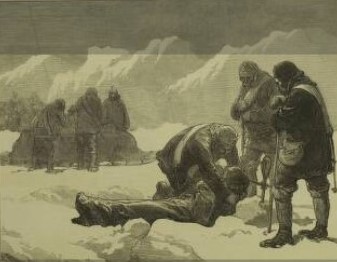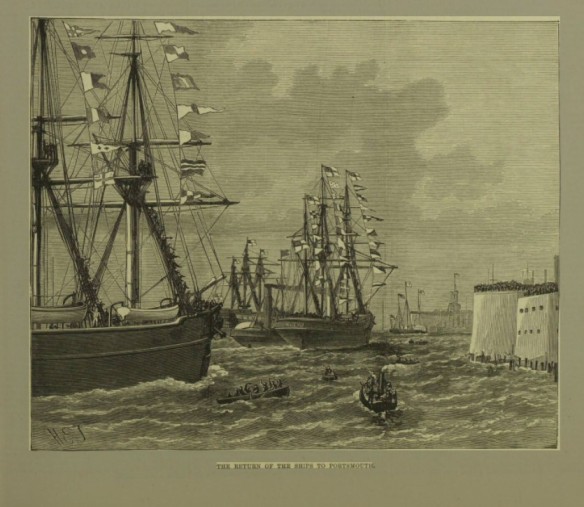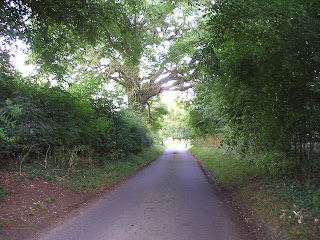Voyage of Discovery - part 2
The Ex-Empress Eugenie (Bonaparte) was so concerned about the men keeping their heads warm that she had made for the sailors of the British Arctic Expedition of 1875 “special woollen wigs” to wear. Nellie, the ship’s Labrador Retriever, would have preferred the same concern for her welfare. It was only when Captain Nares, the leader of the Expedition, enquired further that he realised that the “Esquimaux” [sic] chief wanted her as a gift. Nellie’s black coat had grown thick and luxurious in the freezing temperatures –a jacket made from it would be the most perfect present for his wife. He assured the captain that the meat wouldn’t go to waste either. The image below, shows Nellie rescued and safely returned to England the following year.

Her Majesty’s Ships, HMS Alert and Discovery had left England to rapturous applause. The Expedition to reach the North Pole had captured the imagination, not just of Queen Victoria and the British people but was causing a sensation world-wide. The newspapers had explored every detail of the ships from their build to the foodstuffs they would be carrying, their planned route, the sailors, and the most exciting prospect of all: finding a sub-tropical paradise hidden beyond the ice packs. (The story about the ships departure and the build-up leading to it can be read by clicking this link here). The journey would, of course, discover little else other than ice. Sailing away from port in May 1875 to the sound of cheering and gun salutes the men were in high spirits. These must have given way to deep trepidation when the two ships parted company from one another to sit out the Arctic winter separately amongst the ice floes.

The ships had followed the coastline of Greenland northwards before crossing the sea in fine weather to Cape Isabella. Here the weather changed and they picked their way through floating ice in thick fog. Reaching Lady Franklin Bay, in the northernmost tip of Arctic Canada on 27th August, the Discovery set anchor for the winter, the Alert continuing its journey for another five days before being unable to progress further. When the sun finally disappeared below the horizon on October 12th they would be in total darkness for 142 days. For the sailors, hearing only the sounds of wind and creaking ice, the sense of isolation must have felt all-encompassing. To make matters worse, the sledging crew that had been dispatched to reach the Discovery to give word of the Alert’s position had returned defeated by the weather. They had been out on the ice for twenty days, the last two of which they had travelled in total darkness. Riven with scurvy and affected by frostbite, several of the men needed amputations. To make matters worse, they reported they had seen no land whatsoever.

It would be interesting to know the feelings of sailor John Langston Saggers during this time and whether he was selected to be one of the sledging party. Saggers – who is my ancestral first cousin – was aged 18 when he joined the Royal Navy and his conduct had been exemplary. Five years later he would be aboard the Discovery sailing for the Arctic, perhaps chosen for both his military record and because he had served on Victoria’s royal yacht, HMY Osborne, the ship he would return to in later years. One can only imagine the tales he must have told in his later years of his Arctic adventure.

Great care had been taken prior to departure over the welfare of the men. Apart from warm clothing and adequate food provisions, the sailors were given facilities and equipment to keep them amused during the long winter months. The ships both had theatres for the men to stage plays and they also had equipment to enable them to venture outdoors. The men of the Discovery built a theatre on the ice with a 60ft x 27ft stage which they named after Alexandra, the Princess of Wales. They opened it on her birthday, 1st December with a farce, ‘My Turn Next.’ They also created a skating rink by pouring melted water over the ice which refroze to form a smooth surface. The image below shows the skating rink with HMS Discovery locked in the ice in the background.

The sun reappeared on February 29th and plans were immediately put in place for further sledging expeditions. With over one hundred degrees of frost recorded, one officer was badly affected by the cold. He was returned to the Alert, his comrades taking turns to lie alongside him in an attempt to maintain his body temperature. Although he survived the journey, he died soon after his two badly frostbitten feet had been amputated. A week later, a small party of men led by Lieutenant Rawson reached the Discovery to tell them all was well. The newspapers on hearing of it, reported with special pride that as the men’s frostbitten noses, cheeks and fingers were being treated Rawson jovially said, “at least the cheers from Southsea beach [on their departure from England] have now been fairly earned.”

In April the sledging parties started in earnest with small groups of men travelling in every direction. On board the ships only the chaplains, medical officers and the sick remained alongside half a dozen essential crew members. Exploring further north than any previous expedition, yet separated from one another, the groups remained unaware of the suffering and deaths of one another. Although unsuccessful in reaching the North Pole they brought home with them detail of the birds and animals that they found along their way. Of greater importance for future expeditions, they confirmed for the first time that there was “no open sea” or “an ocean teeming with life” or any “Elysian Fields”, only “an icy desert where all life ends.” Finally, at the end of July 1876, the Alert broke free of the ice to re-join the Discovery and together they began their battle through the slowly thawing sea on the start of their long journey home.

The return of HMS Alert and HMS Discovery to England on Thursday 9th November 1876 was greeted with as much excitement as their departure. Sailing into Portsmouth they were greeted by the Commander-in-Chief of the Fleet, the Lord Mayor, cheering crowds and massed bands. The crew were allowed on shore that evening; the papers reporting proudly that “their behaviour has been excellent.” The following day, back aboard ship, the men received three weeks’ leave and a month’s advance of pay. Over the following weeks the public continued to arrive in the town to visit the ships and an exhibition of the trip.

For the sailors of the Expedition there was still more celebration to come. In early December the Lord Mayor of London entertained the officers and crews to a banquet at the Mansion House. The newspapers noted that “all kinds of wines, and pheasants and plover were served, just as if Her Majesty’s Ministers were present.” The wives and children watched the proceedings from the galleries of the ‘sumptuous” surroundings of the Egyptian Room. At the end of the evening, the men were presented with gifts of pipes and tobacco. Queen Victoria also relayed her gratitude to the men, thanking them for their dedication to service, their heroism and commiserating for the loss of life. She also commanded that “… a medal be granted to all persons of every rank and class who were serving on the Alert and Discovery during the Arctic Expedition of 1875-76…” For the ordinary seaman and his family, it must have been a sight so beyond their usual experience and one that would never be forgotten. Records show that Cousin John Langston Saggers received his medal, albeit with an error engraved into the spelling. Whether it is now in a private collection or still held by a member of his family or has been lost is unknown.

*
Of special interest to my American readers
Captain Nares of the Alert stopped at Polaris Bay, Canada to hoist the American ensign and fire a gun salute. He also erected a brass tablet the expedition had brought with them which read, “Sacred to the memory of Captain F C Hall of the U.S. ship Polaris, who sacrificed his life in the advancement of science on Nov, 8th 1871. This tablet has been erected by the British Arctic Expedition of 1875, who, following in his footsteps, have profited by his experience.”
*
Over the years there would be many more attempts to reach the North Pole. It would not be until 12th May 1926 that Roald Amundsen scientifically proved that he had succeeded.
*
Sources
Ancestry UK
Royal Navy Registers of Seamen’s Services 1848-1939
British Newspaper Archive: The Norwich Mercury, The South London Chronicle, Shetland Times, Fife Herald, The Illustrated London News, Luton Times & Advertiser, The Graphic
British Polar Exploration and Research: A Historical and Medallic Record with Biographies 1818-1999
Wikipedia

Comments
Post a Comment